
Head Surgery Page Menu: 1 2 3 4 5 6 7 8 9 10 11 12 13 14 Next>>
Head Surgery During the Golden Age of Piracy, Page 12
Head Wound Post-Op
"Having removed it [the bone chip], you must apply the other suitable remedies to the wound. " (Hippocrates, On Injuries of the Head, Translated and Edited by Francis Adams, p. 466)
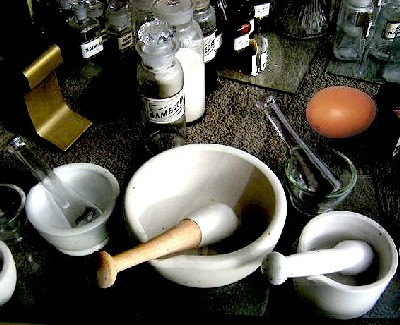
The survival of the patient after a head wound during the golden age of piracy probably owed at least as much to the way the wound was dressed and cared for as it did to any of the operations that were performed on it. If the wound became infected, it would almost certainly result in the death of the patient. Military surgeon Richard Wiseman advised, "But by what I have seen of them [wounds of the brain] heretofore, their Cure consists... in dressing them as Wounds of the Dura mater, and in keeping the Brain within its Membranes; without which no Incarnation [regrowth of tissue] can be made on the Membranes."1
A great deal was written about dressing such wounds and each author had their own method of approaching the problem. This section will look at the medicines and dressings which were used by the surgeons under study. It begins with a discussion of several specific issues initially found in head wounds including dealing with bleeding and dried blood on the dura mater and handling rotting tissue found in the brain after wounding. It will next examine a variety of suggestions on how to medicate the dura mater so that it would heal. Moving outwards from the wound, it will discuss healing contusions of the head, followed by a discussion on bandaging the head after treatment. It will finish with a look at keeping the head warm and the patient comfortable.
1 Richard Wiseman, Of Wounds, Severall Chirurgicall Treatises, 1676, p. 403
Head Wound Post-Op: Eliminating Blood On The Dura Mater
The first problem the surgeon faced when healing a wound of the skull was removing any blood (viscous or dried) sitting on the dura mater. This was true whether the skull was trepanned or not. (Keep in mind that one of the reasons for trepanning was to give vent to blood which had been trapped under the skull.)
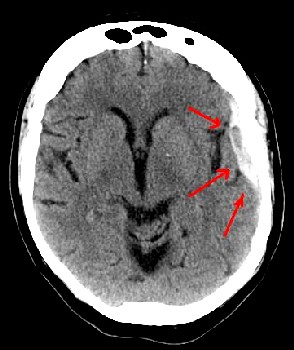
Photo: Lucian Monfils
A Subdermal Hematoma (Bleeding Under the Skull)
After a lengthy review of the way various surgeons in history dealt with this, Richard Wiseman explains that "the most part of the Ancients [revered ancient physicians], and many of the Moderns, have advised Lenients [softening medicines], as ol. ros.[oil of roses] that the bloud extravasated [leaking], and lying upon the Dura mater, in pus convertatur [so, in turn], may be digested [broken down]. But in this you are to be guided by your Eye."1
Sea surgeon John Moyle has quite a bit more to say on the subject in his case studies. In one he explains that coagulated blood on the dura mater "was absterged [cleansed] with Linteolum [a small linen cloth], and with Lint on the end of a Probe; and then the Tunicle [internal membrane - dura mater] was wash’d with this [medicine] of the Antients [ancient physicians], warm’d. Rx. Spt. Vin. [spirit of wine] {1 ounce} Syr. Ros. Sicc. [strained syrup of roses] {1 ounce} misce. f. Emmaton. [make into a liniment.]"2 After this treatment, "to folcillate [nourish] the Brain, as to obsorb any sanguinous [bloody] Humor that might remain extravasated [leaking], a Flannel Stupe, expres’d out of warm Vin. Rub. [red wine] was applied."3
In another case study, Moyle explains how a piece of lint with a thread tied to it (for easier future removal from the wound) was dipped in "Rx. Ol. Ros. [oil of roses] {1 ounce} Resin. Abiet. [pine resin] {1 ounce} dissol. ad ignem. misce [stir until dissolved]. This was applied to the brain through the Foramen [opening], upon the dura Meninx [dura mater], to digest [break down] and discuss [disperse] any Blood or Matter that might remain in, and oppress the Tunicles [membrane]. So a Dossel of dry Lint was put into the Foramen, and a Pledget of the same on the Fissure, and over the Bone, as far as it was bare; not only to defend from the cold Air, but also to obsorb any Gleet [runny discharge], that lying on the Bone, would quickly turpify [become foul] and rot it."4
It is interesting that so many rose-based medicines are featured in these medicines. Several modern scientific studies have shown that Damascus rose essential oil has 'strong antibacterial' properties and so might have been beneficial in preventing infection.5
1 Richard Wiseman, Of Wounds, Severall Chirurgicall Treatises, 1676, p. 381; 2 John Moyle, Memoirs: Of many Extraordinary Cures, 1708, p. 2-3; 3 Moyle, p. 3; 4 Moyle, p. 14-5; 5 Mohammad Hossein Boskabady, Mohammad NaserShafei, Zahra Saberi and Somayeh Amini, "Pharmacological Effects of Rosa Damascena", Iran J Basic Med Sci., 2011 Jul-Aug; 14(4), pp. 295–307
Head Wound Post-Op: Treating Rotting Tissue
A problem similar to removing blood on the dura mater occurred when the tissue in an open wound of the skull had began to degrade. The treatments suggested for this shared much in common with eliminating blood on the dura mater.
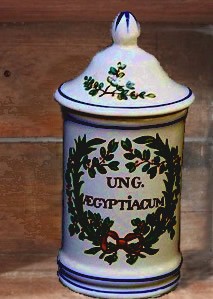
Unguentum Aegyptiacum
Richard Wiseman said, "If there be Sanies [serum, blood and/or pus, discharged by wounds] or Putrifaction [rotting of the tissue], mel. ros. [honey of roses], spir. Vini [spirit of wine], and higher Detergents [cleansing medicines] may be used, accordingly as the Putrefaction is more or less."1 When the tissue degradation had been the result of "the long lying of concreted [hardened] bloud, &c. then mel. ros. and spir. vini are proper, yea [use] mel. Ægyptiac. [Ægyptiacum Unguent] and higher if occasion shall offer."2 Ægyptiacum unguent was a strong cleaning medicine according to John Woodall. He said that it "serveth to scower; it mundifieth [cleanses] all rotten foule ulcers, and is best to be put into the griefe scalding hot... for preventing them [poisoned wounds] from feare of a Gangreene it excelleth."3
In one of his case studies, sea surgeon John Moyle treated a wound that "was ulcerated with the corrupt Sanies, and it smelt strong and offensive. Now my intention was first to mundifie [cleanse] it well, and to that intent I washed it with that known and approved Emmaton [liniment] of Mel. Ros. & Spt. vini, mix’d and warm, by a fine Linteolum [small linen cloth] on the End of a Probe" which he applied to the dura mater.4 This is the same medicine that Wiseman used initially on such wounds.
Once that was applied, Moyle carefully filled the opening in the
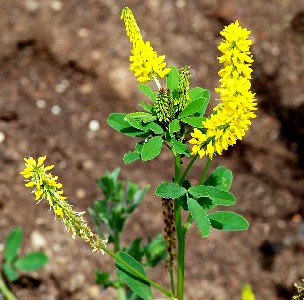
Photo: Wiki user Alvesgaspar - Melilot
skull "with a Dossel of Stupa Sicca [dry tow or coarse linen] to imbibe the Sanies, that the Brain should expume [rub off the fouled material]; and covered the Bone likewise with Pledgets of the same [material], and dressed the Wound with the Balsam following. Rx. Tereb. scio [Cypress turpentine] {3 ounces} Gum Elemi [gum resin] {2 ounces} Spt. vin. [spirit of wine] {1.5 ounce} Ol. Hyperic. [oil of St. John's wort] {1 ounce} Coque ad Consump. Humidit. [cook until all the liquid is consumed] Adde Thur. Pulver. [powdered frankincense] {2 drams} Croc. [saffron] {1 scruple} f Balsam [make into a balsam]. Over this was applied Emplasterum de Mellilot. And so Compress and Bandage."5
This intricate balsam recipe contains a variety of items that would have been thought good for healing rotting wounds in the skull. It containing cleansing medicines such as the turpentine and spirit of wine; healing medicines such as the oil of St. John's wort and powdered frankincense; and medicines that were thought to be good for the head such as powdered frankincense (serving double duty), gum elemni and saffron. As for the plaster, apothecary and physician Nicholas Culpeper noted that the Melilot Plaster was "a gallant drawing and healing plaister, no way offensive to any part of the body."6
1 Richard Wiseman, Of Wounds, Severall Chirurgicall Treatises, 1676, p. 381; 2 Wiseman, p. 381-2; 3 John Woodall, the surgions mate, 1617, p. 45; 4 John Moyle, Memoirs: Of many Extraordinary Cures, 1708, p. 20; 5 John Moyle, p. 20-1; 2 Nicholas Culpeper, Pharmacopœia Londinesis, 1720, p. 247
Head Wound Post-Op: Healing the Dura Mater (Meninx/Membrane)
Several medicines were mentioned by surgeons for treating the dura mater, although there is a definite pattern to the types of medicines that were preferred for this task.
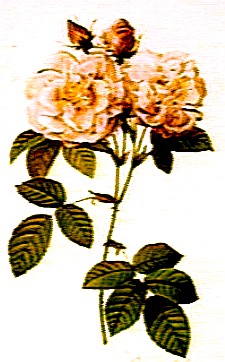
Damask Roses, After P. J. Redoute, From
The Wellcome Collection (1824)
Richard Wiseman was fairly consistent in recommending a particular medicine for application to the dura mater - resin combined with oil of roses. You may recall from the previous page that he suggested this same medicine for treating the dura mater after trepanning. He even defended it as proper when observers of his surgery protested by explaining, "I would cure this Patient without applying any other Remedy to the Dura mater than these two simple Medicaments"1.
Wiseman elsewhere explains that in 'common cases' (those without complications such as blood on the dura mater or rotting tissue) that "Resin by its emplastick [adhesive] quality mixed with ol. ros. perfects the concoction [the creation of new tissue in the wound] sooner, and by its anodyne [soothing] quality secures the Part from Inflammation.... by this simple Medicament I never failed of good Digestion [creation of new tissue]."2
Wiseman goes on to suggest several refinements the surgeon may want to employ when using this medicine. For example, "It ought to be proportioned to the Habit of body: dry Bodies require more of the Resin and less Oil."3 He elsewhere notes, "I have deterged [cleansed] and digested [generated new skin], always continuing the use of it until the Membrane was well digested, never finding the least prejudice the bare Bone received from it."4
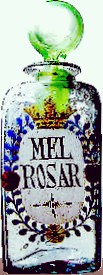
Honey of Roses
Apothecary Jar
As the patient begins to heal, Wiseman recommends 'tempering' it. He suggests that "after Digestion [once all the impurities have been purged from the wound] add more Resin, and less Oil. Or you may mix mel. ros. [honey or roses] with the Resin in stead of the Oil, which will answer your intention, both to deterge [cleanse] and incarne [promote the growth of tissue]."5
Similar to Wiseman, sea surgeon John Woodall advises that once a wound has been cleaned, the surgeon should "poure mel rosarum warme into the wound, or two parts of Hony, and one part of oyle or syrupe of drie Roses"6.
Sea surgeon John Moyle employs a sindon (medicated piece of cloth) "form’d Adequate to the Fracture; and being dipt in... Rx. Ol. Ros. Rub. [oil of red roses] {2 ounces} Resin. Abiet. [pine resin] {2 drams} misce [mixed]. [You may recall that this is the same medicine that Moyle used to digest blood on the membrane.] Its Edges were placed smoothly under the Coronæ Fracturæ [fracture of the skull] with a Lenticuler. This was to digest and heal the vulnerate [wounded] Membrane, and also to suppress the Tumid Tunicle [swollen membrane] from extuberating [swelling out]"7.
Reminiscent of Wiseman's suggestions, sea surgeon John Moyle advised washing the dura mater "with warm Spt. Vini. [spirit of wine] & Syr. Ros. Siccar. [strained syrup of roses] misce. [mixed] by a fine Linteolum [small piece of lint] fastned on the end of a Probe: And by this time a warm Stupe was ready, being expressed out of
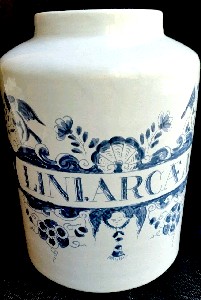
Liniment Arcaei Apothecary Jar
Vinum Rubrum [red wine], wherein the vulnerary [healing] Herbs had infused; which
was used also each Dressing."8 You may notice that Moyle is using the same cleansing concoction he advised to clean blood off the dura mater in the previous section.
In addition to honey of roses, Woodall suggests alternative medicines including "common Honey with Terpintine, with the yolke of an egge, which are remedies mundifying [cleansing], and gratefull to the Membrans [the dura mater], and ought to be applied warme, but above all others the linament of Arceus is the chiefest Balsame in the head."9 He details the application of his liniment, explaining that it should be applied "somewhat hotter then the partie would willingly beare it, annoint the wound therewith in each place, with a little soft lint on a Prob[e]s end, leaving the said lint therein"10.
Woodall elsewhere enthuses that liniment Arcæi is "a Balme for new wounds, especially in the head, as that a better can scarse be found out by Art."11 Physician Nicholas Culpeper says that "it gently cleanseth and filleth up an Ulcer with flesh, it being of a mild nature, and friendly to the body."12
French surgical instructor Pierre Dionis also uses honey of roses, although he combines it with a different medicine.
_Pierre_Dionis_1708.jpg)
Membrane Dressings, From A course of chirurgical operations,
By Pierre Dionis, Table 32, (1708)
The first Thing which we do, is to pour on the Dura-Mater some Drops of white Balsam [unguentum album] contained in the Viol C; we warm the Spoon D, in which is some Mel Rosat [honey of roses], to mix with a little of this white Balsam; in which Mixture we dip the two Sindons [medicated cloths], of which one is of Linen, E, and the other of Lint, F; we lay the first on the Dura-Mater, and being larger than the Hole in the Cranium, we thrust all its Circumference in betwixt the Skull and the Membrane, by Means of Lenticular G; we thrust in the second after it, and proceed wholly to fill up the Hole with a Linten Stopple, H.13
Dionis is not one to skimp on details. Notice the unusual form of the lenticular to be used here - they usually have a smooth bottom to avoid damaging the dura mater.
Though it has a 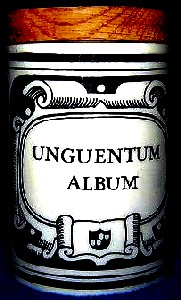
Unguentum Album Apothecary Jar
different name, the core of Unguentum Album was Wiseman's standby: oil of roses. This was combined with wax and a little bit of camphor. Woodall noted that Unguentum Album had wound healing and analgesic properties.14 Camphor was said to alleviate pain (thus the analgesic quality) as well as fight poisons and prevent 'putrefaction' or rotting of the membrane.
Once medicine was placed on the membrane, some of the surgeons explained how to dress the wound itself. Woodall simply recommends filling the orifice with dry lint.15 Like Woodall, Moyle uses "a Dossel of dry Lint applied in the Chasma [perforation in the skull], and Pledgits of the same over the Denude[d]-bone; to the end that no Gleet [runny discharge] from the Labiæ vulneris [lips of the wound] should insinuate into the Chasma, nor yet Contaminate the Skull; as also to defend from the piercing Air, that would soon alter the Bone from its natural Colour to a labascous Hue."16
Richard Wiseman suggests something similar, adding a little medicine. He tells the surgeon to "fill up the place opened with Dossils [small rolls] of dry Lint, or pressed out of Red wine or Oxycrate [an astringent composed of water and vinegar], or a Sponge prest out of either of the same Liquors"17.
_Pierre_Dionis_1708.jpg)
Dressings & Instruments, From A course of
chirurgical
operations,
By Pierre Dionis, Table 32, (1708)
Dionis' process is a more intricate, which isn't surprising given his attention to detail. He suggests that the
wound be covered
"with the Pledget I, after having dabb’d the Part of the Skull which is uncover’d with Spirit of Wine, and with the Forceps K, the four small Stopples L L L L, which we wet in the Digestive M [a digestive is a medicine that promotes the generation of flesh in a wound], in order to place them one after another on the Wound, the Middle of which is filled with two other small Stopples N N, dipped in the same Digestive; and having cover’d with the same Digestive, by the Spatula O18
Although Dionis' description is more complex, involving a variety of types and shapes of lint dressings, he is basically using the same procedure as Woodall. Unlike Woodall, however, he adds medicines to each of these dressings.
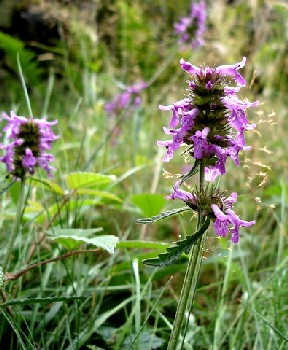
Photo: Ian Cunliffe - Betony Stachys Officinalis
Once the opening that exposes the dura mater is filled with dressings, Woodall recommends a variety of plasters that can be used to cover the wound. These include Plasters of Betony, Melilot, Minium or Stipticum.19 These plasters are all said to have wound cleansing, drawing and flesh generating properties. Culpeper notes that the betony plaster in particular "is a gallant Plaister to unite the skull when it is cracked"20.
Woodall goes on to advise the use of 'linament of Arceus' on the wound. He provides a wide variety of alternatives to this, explaining that if the surgeon doesn't have it, he can use the old standbys - oil or honey of roses, "which are not inferior much to the former, being warme applied", or olive oil and honey or "spirit of wine, or good aqua vitæ with the former medicine". He explains that these medicines "comforteth well the braine, and very much furthereth good and speedy healing, [along with] good bowlstring [bolstering - support of the wound using compresses], and ligature [tight binding with bandages] dothe much availe to the cure of wounds of the head."21
Wiseman likewise applies "a Plaister over all of diachalcith. [Emplastrum Dialchalciteos - a plaster designed to prevent infection and heal wounds] malaxed [kneaded] with ol. ros. cum aceto [oil of roses with vinegar], and bind it up."22
For his part, Dionis suggests employing
_Pierre_Dionis_1708.jpg)
Head Wound Finishing Dressings, From A course of chirurgical operations, By Pierre Dionis, Table 32, (1708)
two large Pledgets P P, we lay them over all the rest, making an Embrocation [liniment] of Oil of Roses contained on the Plate Q [not shown in his diagram], which must be held to the Fire to warm that Liquor before we rub it all over the Wound: Then we lay on the Betony Plaister R, which we cover with the Bolster S, and that with the Napkin T, over it: Then we proceed to make the Bandage call’d the Coverchief23
Here again we find oil of roses in treating the wounds of the head. Like Woodall, Dionis suggests a plaster - betony - relying on one of the plasters most recommended for head wounds by Culpeper.
1 Richard Wiseman, Of Wounds, Severall Chirurgicall Treatises, 1676, p. 394; 2,3,4,5 Wiseman, p. 382; 6 John Woodall, the surgions mate, 1617, p. 135; 7 John Moyle, Memoirs: Of many Extraordinary Cures, 1708, p. 3; 8 Moyle, p. 14; 9,10 Woodall, p. 135; 11 Woodall, p. 51; 12 Nicholas Culpeper, Pharmacopœia Londinesis, 1720, p. 224; 13 Pierre Dionis, A course of chirurgical operations: demonstrated in the royal garden at Paris. 2nd ed., p. 287; 14 Woodall, p. 45; 15 Woodall, p. 136; 16 Moyle, p. 14; 17 Wiseman, p. 380; 18 Dionis, p. 287; 19 Woodall, p. 136; 20 Culpeper,p. 240; 21 Woodall, p. 136; 22 Wiseman, p. 380; 23 Dionis, p. 287

